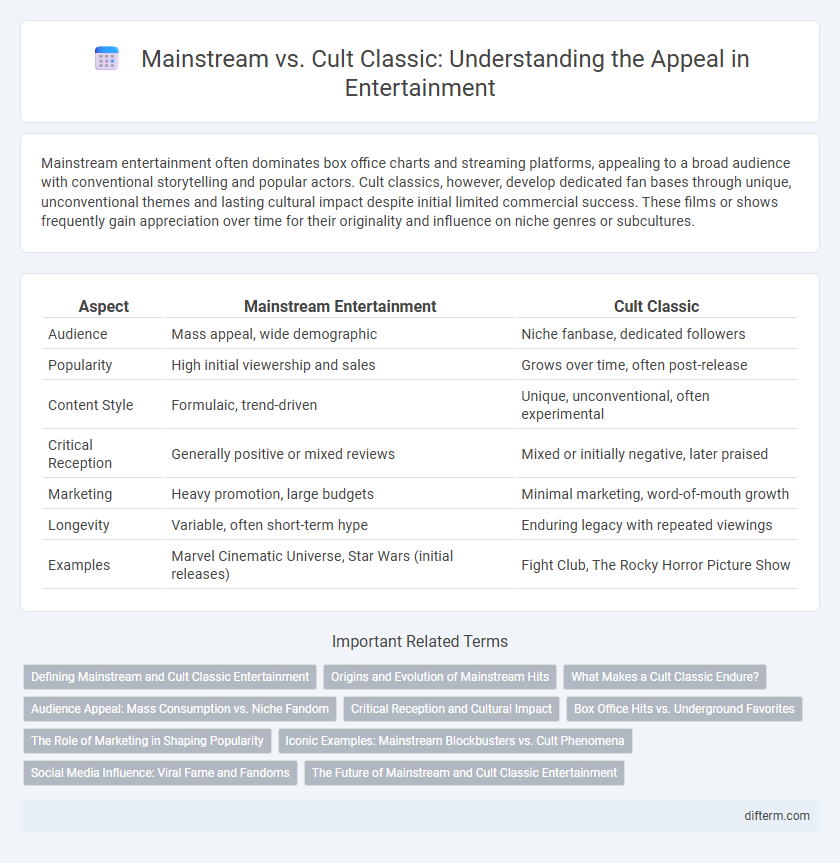Mainstream entertainment often dominates box office charts and streaming platforms, appealing to a broad audience with conventional storytelling and popular actors. Cult classics, however, develop dedicated fan bases through unique, unconventional themes and lasting cultural impact despite initial limited commercial success. These films or shows frequently gain appreciation over time for their originality and influence on niche genres or subcultures.
Table of Comparison
| Aspect | Mainstream Entertainment | Cult Classic |
|---|---|---|
| Audience | Mass appeal, wide demographic | Niche fanbase, dedicated followers |
| Popularity | High initial viewership and sales | Grows over time, often post-release |
| Content Style | Formulaic, trend-driven | Unique, unconventional, often experimental |
| Critical Reception | Generally positive or mixed reviews | Mixed or initially negative, later praised |
| Marketing | Heavy promotion, large budgets | Minimal marketing, word-of-mouth growth |
| Longevity | Variable, often short-term hype | Enduring legacy with repeated viewings |
| Examples | Marvel Cinematic Universe, Star Wars (initial releases) | Fight Club, The Rocky Horror Picture Show |
Defining Mainstream and Cult Classic Entertainment
Mainstream entertainment typically features widely popular films, music, or media that achieve high commercial success and extensive audience reach, often driven by major studios and mass marketing. Cult classic entertainment, by contrast, gains a dedicated and passionate fan base over time despite limited initial success or niche appeal, frequently characterized by unique storytelling, unconventional themes, and strong emotional or cultural resonance. The distinction hinges on popularity scale and audience engagement, with mainstream targeting broad consumption and cult classics fostering loyal subcultures.
Origins and Evolution of Mainstream Hits
Mainstream hits typically originate from major studios or record labels with wide-reaching marketing campaigns, ensuring rapid exposure and mass appeal. These hits evolve through continuous radio play, streaming algorithms, and media coverage that reinforce their popularity over time. Unlike cult classics, mainstream hits often reflect current cultural trends and commercial viability, driving their sustained presence in popular entertainment.
What Makes a Cult Classic Endure?
Cult classics endure due to their passionate fanbase, unique storytelling, and cultural resonance that mainstream films often lack. These movies frequently challenge conventional norms, creating a distinct identity that fosters repeated viewings and community engagement. Over time, their unconventional appeal and quotable dialogue cement their status beyond mainstream popularity.
Audience Appeal: Mass Consumption vs. Niche Fandom
Mainstream entertainment captivates mass consumption by appealing to broad demographics through familiar themes and accessible storytelling techniques. Cult classics thrive on niche fandoms, offering unique, often unconventional narratives that foster deep emotional connections and community among dedicated viewers. The contrast in audience appeal drives differing marketing strategies and longevity, with mainstream hits enjoying widespread visibility and cult films building enduring, passionate followings.
Critical Reception and Cultural Impact
Mainstream entertainment often enjoys widespread critical acclaim and significant box office success, reflecting broad audience appeal and substantial marketing efforts. Cult classics typically receive mixed or niche critical reception upon release but develop dedicated fanbases and lasting cultural impact through unique storytelling and memorable characters. The cultural resonance of cult films usually influences independent filmmakers and inspires fan communities long after their initial debut.
Box Office Hits vs. Underground Favorites
Box office hits dominate mainstream entertainment with blockbuster revenues often exceeding $500 million, driven by extensive marketing and wide theatrical releases. Cult classics typically generate modest box office returns but achieve lasting popularity through dedicated fanbases, often bolstered by home video sales, streaming platforms, and midnight screenings. The contrast highlights commercial success versus cultural impact, where underground favorites shape niche communities despite limited initial exposure.
The Role of Marketing in Shaping Popularity
Marketing strategies significantly influence the popularity of mainstream films by targeting broad audiences through extensive advertising campaigns, merchandise, and media presence. Cult classics often gain recognition through niche marketing, word-of-mouth, and grassroots efforts rather than large-scale promotional budgets. The disparity in marketing resources shapes audience perceptions, driving mainstream success while cult classics rely on passionate fan engagement to sustain long-term interest.
Iconic Examples: Mainstream Blockbusters vs. Cult Phenomena
Mainstream blockbusters like "Avengers: Endgame" and "Jurassic Park" dominate global box offices with massive budgets, widespread marketing, and broad audience appeal. In contrast, cult classics such as "The Rocky Horror Picture Show" and "Donnie Darko" develop dedicated fanbases through unique storytelling, unconventional themes, and repeated viewings over time. These cult phenomena often influence niche subcultures and inspire fan rituals, distinguishing them from the transient popularity of mainstream hits.
Social Media Influence: Viral Fame and Fandoms
Mainstream entertainment often gains rapid exposure through widespread social media platforms, leveraging algorithms to achieve viral fame and reach diverse audiences quickly. Cult classics build dedicated fandoms over time, with niche communities amplifying their appreciation through memes, fan art, and online discussions on platforms like Reddit and Tumblr. The intensity of these fandoms creates sustained engagement, influencing streaming trends and merchandise sales even years after initial release.
The Future of Mainstream and Cult Classic Entertainment
Mainstream entertainment continues to leverage massive budgets and global distribution channels to captivate broad audiences, while cult classics thrive through niche appeal and dedicated fan communities fostering long-term engagement. Streaming platforms and digital media have blurred traditional boundaries, enabling cult classics to gain renewed visibility and influence beyond limited initial releases. Audience demand for diverse, authentic storytelling propels both mainstream productions and cult classics toward innovative content strategies and hybrid models of entertainment consumption.
mainstream vs cult classic Infographic

 difterm.com
difterm.com